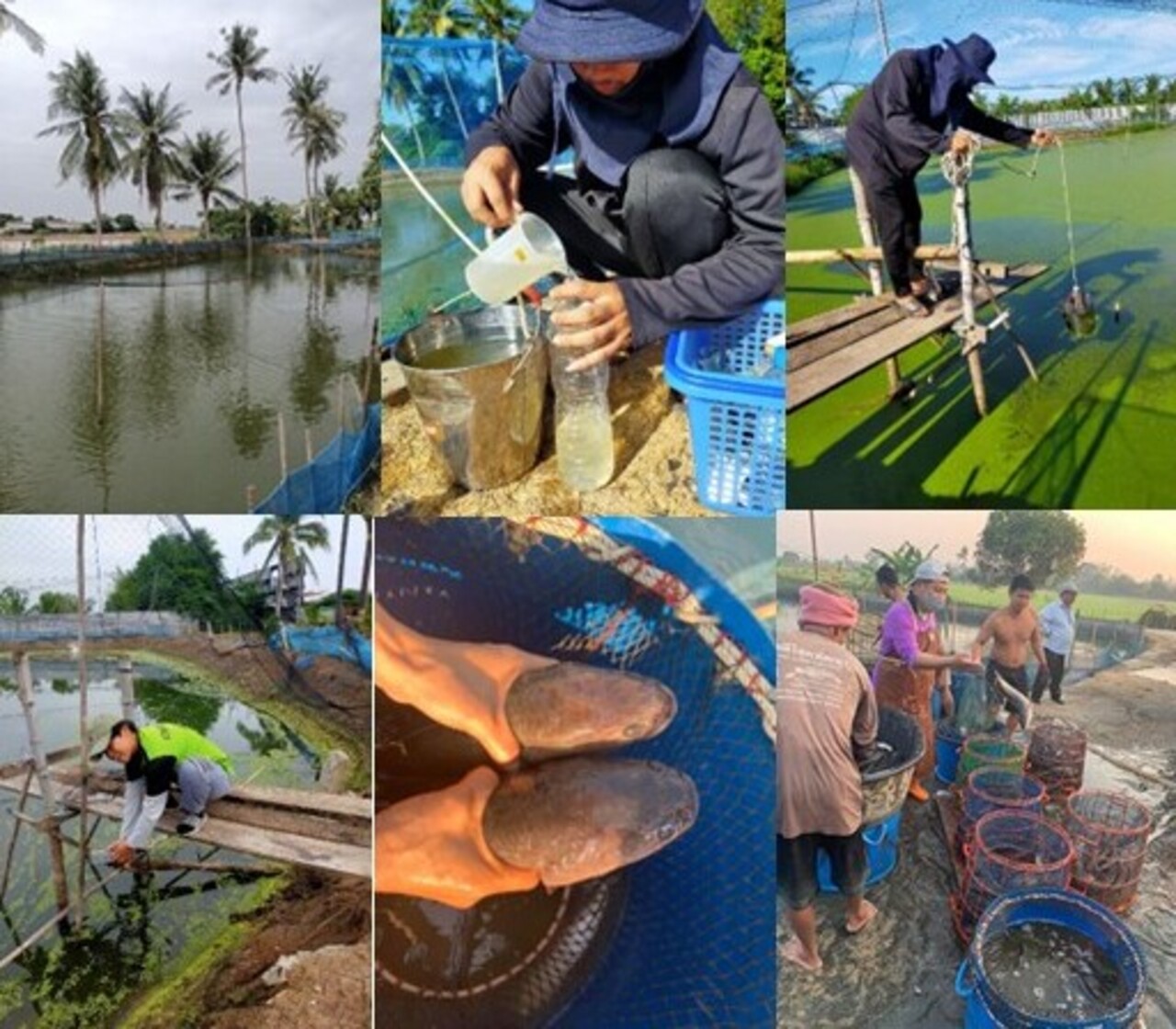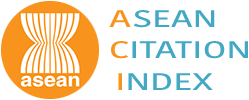ดุลไนโตรเจนของการเลี้ยงปลาช่อนแบบหนาแน่นในบ่อดินภายใต้ความถี่ การถ่ายน้ำที่แตกต่างกัน กรณีศึกษา : กลุ่มสหกรณ์ประมงและการแปรรูปอ่างทอง
คำสำคัญ:
ดุลไนโตรเจน , การเปลี่ยนถ่ายน้ำ, การเลี้ยงแบบหนาแน่น, ปลาช่อนบทคัดย่อ
วัตถุประสงค์และที่มา : การเลี้ยงปลาช่อนแบบหนาแน่นในบ่อดินของเกษตรกรในจังหวัดอ่างทอง ไม่มีระบบการเติมอากาศ เกิดการสะสมของเสียตามระยะเวลาในการเลี้ยง จึงต้องเปลี่ยนถ่ายน้ำด้วยปริมาตรและความถี่ที่แตกต่างกัน น้ำทิ้งที่ปล่อยมักมีสารประกอบไนโตรเจนสูง โดยเฉพาะแอมโมเนียและไนเตรท ซึ่งจะส่งผลต่อคุณภาพน้ำในแหล่งน้ำธรรมชาติและสิ่งแวดล้อม เนื่องจากขาดข้อมูลการจัดการความถี่ในการเปลี่ยนถ่ายน้ำที่เหมาะสมต่อการเจริญเติบโตของปลา ในการศึกษาครั้งนี้ จึงได้ศึกษาผลของความถี่ในการเปลี่ยนถ่ายน้ำที่แตกต่างกัน 3 ระดับต่อผลผลิตรวมของปลาช่อน และการเปลี่ยนแปลงดุลไนโตรเจนในบ่อเลี้ยงปลาช่อนแบบหนาแน่นในบ่อดินที่มีความถี่ในการเปลี่ยนถ่ายน้ำต่างกัน
วิธีดำเนินการวิจัย : วางแผนการทดลองแบบสุ่มตลอดอย่างสมบูรณ์ (completely randomized design) โดยแบ่งความถี่ในการเปลี่ยนถ่ายน้ำเป็น 3 ชุดการทดลอง ได้แก่ ชุดการทดลองที่ 1 ระบบการเลี้ยงปลาช่อนที่เปลี่ยนถ่ายน้ำ สัปดาห์ละ 1 ครั้ง (T1), ชุดการทดลองที่ 2 สัปดาห์ละ 2 ครั้ง (T2) และ ชุดการทดลองที่ 3 สัปดาห์ละ 3 ครั้ง (T3) ทำการทดลองแต่ละชุดจำนวน 3 ซ้ำ ทดลองในบ่อดิน ขนาด 1 ไร่ (1,600 ตารางเมตร) เติมน้ำลึก 150 เซนติเมตร ปริมาตรน้ำ 2,400 ลูกบาศก์เมตร ปล่อยปลาที่มีน้ำหนักเฉลี่ยเริ่มต้น (±SD) 5.01 ± 0.87- 5.47 ± 0.69 กรัม ในอัตราความหนาแน่น 10,000 ตัว/บ่อ (6.25 ตัว/ตารางเมตร) เก็บข้อมูล น้ำหนักปลารวม ปริมาณอาหารที่ใช้เลี้ยงปลา วิเคราะห์คุณภาพน้ำ ข้อมูลปริมาณตะกอน และข้อมูลปริมาณไนโตรเจนรวมในอาหาร น้ำ ตัวปลาและดินตะกอน และนำข้อมูลที่ได้ไปคำนวณดุลไนโตรเจน
ผลการวิจัย : พบว่า น้ำหนักปลารวมสุดท้ายเฉลี่ย (+SD) ของ T2 (การเปลี่ยนถ่ายน้ำ 2 ครั้ง/สัปดาห์) (9,000.00 ± 17.65 กิโลกรัม) และ T3 (การเปลี่ยนถ่ายน้ำ 3 ครั้ง/สัปดาห์) (9,137.00 ± 11.25 กิโลกรัม) มีผลผลิตที่สูงกว่าอย่างมีนัยสำคัญทางสถิติ (p<0.05) เมื่อเทียบกับ T1 (การเปลี่ยนถ่ายน้ำ 1 ครั้ง/สัปดาห์) (8,600.00 ± 15.14 กิโลกรัม) ส่วนปริมาณอาหารที่ใช้ในการเลี้ยงปลาของทั้งสามชุดการทดลองไม่มีความแตกต่างกันอย่างมีนัยสำคัญทางสถิติ (p>0.05) และอัตราการเปลี่ยนอาหารเป็นเนื้อเฉลี่ยของปลาใน T2 (1.536 ± 0.001) และ T3 (1.500 ± 0.001) มีค่าต่ำกว่าอย่างมีนัยสำคัญทางสถิติ (p<0.05) เมื่อเทียบกับ T1 (1.603 ± 0.002) ดุลไนโตรเจนในการเลี้ยงปลาช่อนที่มีระบบการจัดการต่างกัน 3 ระบบ พบว่าปริมาณไนโตรเจนในบ่อมีแหล่งที่มาจาก อาหารปลา ดินพื้นบ่อ และน้ำเลี้ยงปลา ตามลำดับ แหล่งที่มาหลักของไนโตรเจนในบ่อปลาของทั้งสามชุดการทดลอง มาจากอาหารปลา โดย T1 มีปริมาณไนโตรเจนจากน้ำที่เติมเข้าบ่อ 4.1 ± 1.12 เปอร์เซ็นต์ ละลายออกมาจากดิน 12.7 ± 2.61 เปอร์เซ็นต์ และจากอาหารปลา 83.2 ± 4.17 เปอร์เซ็นต์ T2 มีปริมาณไนโตรเจนจากน้ำที่เติมเข้าบ่อ 5.7 ± 1.04 เปอร์เซ็นต์ ละลายออกมาจากดิน 14.0 ± 1.00 เปอร์เซ็นต์ และจากอาหารปลา 80.3 ± 2.18 เปอร์เซ็นต์ T3 มีปริมาณไนโตรเจนจากน้ำที่เติมเข้าบ่อ 5.2 ± 1.32 เปอร์เซ็นต์ ละลายออกมาจากดิน 13.8 ± 2.15 เปอร์เซ็นต์ และจากอาหารปลา 81.0 ± 1.83 เปอร์เซ็นต์ แหล่งที่มาของไนโตรเจนจากน้ำที่ใช้เลี้ยงปลาพบว่า ใน T2 และ T3 มีปริมาณไนโตรเจนนำเข้าสูงกว่าอย่างมีนัยสำคัญทางสถิติ (p<0.05) เมื่อเทียบกับ T1 ในขณะที่แหล่งที่มาของไนโตรเจนที่ละลายออกมาจากดินในบ่อ พบว่า ทั้งสามชุดการทดลองไม่มีความแตกต่างอย่างมีนัยสำคัญทางสถิติ (p>0.05) สำหรับแหล่งที่มาของไนโตรเจนจากอาหารปลา พบว่า ใน T1 มีปริมาณไนโตรเจนนำเข้าจากอาหารปลาสูงกว่าอย่างมีนัยสำคัญทางสถิติ (p<0.05) เมื่อเทียบกับ T2 และ T3 ส่วนการสูญเสียไนโตรเจนในบ่อ โดยการสะสมในตัวปลา ในดินเลน ในน้ำทิ้ง และอื่นๆ ที่ไม่สามารถระบุได้ (non-detected) แหล่งที่สูญเสียไนโตรเจนหลักในบ่อปลาของทั้งสามชุดการทดลอง คือการสะสมในตัวปลา ในขณะที่ T1 มีปริมาณไนโตรเจนที่สูญเสียจาก น้ำทิ้ง 22.1 ± 2.83 เปอร์เซ็นต์ ในตัวปลา 35.0 ± 2.12 เปอร์เซ็นต์ ในดินเลน 35.2 ± 2.44 เปอร์เซ็นต์ และอื่น ๆ 12.8 ± 3.80 เปอร์เซ็นต์ สำหรับ T2 มีปริมาณไนโตรเจนที่สูญเสียจาก น้ำทิ้ง 19.5 ± 2.33 เปอร์เซ็นต์ ในตัวปลา 28.6 ± 1.65 เปอร์เซ็นต์ ในดินเลน 30.1 ± 3.61 เปอร์เซ็นต์ และอื่นๆ 16.7 ± 4.33 เปอร์เซ็นต์ ส่วน T3 มีปริมาณไนโตรเจนที่สูญเสียจาก น้ำทิ้ง 17.8 ± 4.02 เปอร์เซ็นต์ ในตัวปลา 38.4 ± 3.17 เปอร์เซ็นต์ ในดินเลน 27.4 ± 1.78 เปอร์เซ็นต์ และและอื่น ๆ 16.4 ± 4.12 เปอร์เซ็นต์ การสูญเสียไนโตรเจนออกจากบ่อโดยการปล่อยน้ำทิ้ง พบว่า ใน T1 มีปริมาณไนโตรเจนสูญเสียออกจากบ่อสูงกว่าอย่างมีนัยสำคัญทางสถิติ (p<0.05) เมื่อเทียบกับ T2 และ T3 เป็นเช่นเดียวกันกับการสูญเสียไนโตรเจนออกจากบ่อโดยการสะสมในดินเลนพื้นบ่อและการสูญเสียไนโตรเจนออกจากบ่อทางอื่นๆ ที่ไม่สามารถระบุได้ ในทางกลับกันการสูญเสียไนโตรเจนออกจากบ่อโดยการสะสมอยู่ในตัวปลา พบว่า ใน T3 มีปริมาณไนโตรเจนสูญเสีย สูงกว่าอย่างมีนัยสำคัญทางสถิติ (p<0.05) เมื่อเทียบกับ T1 และ T2
สรุปผลการวิจัย : ในการเลี้ยงปลาช่อนแบบหนาแน่นในบ่อดินที่มีความถี่ในการเปลี่ยนถ่ายน้ำที่แตกต่างกัน 3 ระบบ พบว่าปลาใน T2 และ T3 (ความถี่ในการเปลี่ยนถ่ายน้ำ 2 และ 3 ครั้ง/สัปดาห์) มีน้ำหนักปลารวมสุดท้ายสูงกว่า และอัตราการเปลี่ยนอาหารเป็นเนื้อต่ำกว่า ปลาใน T1 อย่างมีนัยสำคัญทางสถิติ (p<0.05) ส่วนแหล่งที่มาหลักของไนโตรเจนในบ่อปลามาจากอาหารปลาเฉลี่ย (±SD) อยู่ในช่วง 80.3 ± 2.18 - 83.2 ± 4.17 เปอร์เซ็นต์และการสูญเสียไนโตรเจนออกไปจากบ่อในรูปของตัวปลาเฉลี่ย (±SD) อยู่ในช่วง 35.0 ± 2.12 - 38.4 ± 3.1 เปอร์เซ็นต์ อัตราการเปลี่ยนถ่ายน้ำที่เหมาะสมสำหรับการเลี้ยงปลาช่อนแบบหนาแน่นในบ่อดิน คือ 2 ครั้ง/สัปดาห์
เอกสารอ้างอิง
Adhikari, S., Sahu, B. C., Mahapatra, A. S., & Dey, L. (2014). Nutrient budgets and effluent characteristics in giant freshwater prawn (Macrobrachium rosenbergii) culture ponds. Bulletin of environmental contamination and toxicology, 92, 509-513. doi.org/10.1007/s00128-014-1227-4.
Ajiboye, A. O., Awogbade, A. A., & Babalola, O. A. (2015). Effects of water exchange on water quality parameters, nutrient utilization and growth of African catfish (Clarias gariepinus). International Journal of Livestock Production, 6(5), 57-60. doi.org/10.5897/IJLP2015.0256.
AOAC. (2000). Official methods of analysis of the Association of Official Analytical Chemists. 17th ed. Association of Official Analytical Chemists & Association of Official Agricultural Chemists. USA: Association of Official Analytical Chemists.
Barbieri, E., & Doi, S. A. (2012). Acute toxicity of ammonia on juvenile cobia (Rachycentron canadum, Linnaeus, 1766) according to the salinity. Aquaculture International, 20(2), 373-382. doi.org/10.1007/s10499-011-9467-3.
Casillas-Hernández, R., Magallón-Barajas, F., Portillo-Clarck, G., & Páez-Osuna, F. (2006). Nutrient mass balances in semi-intensive shrimp ponds from Sonora, Mexico using two feeding strategies: Trays and mechanical dispersal. Aquaculture, 258(1-4), 289-298. doi.org/10.1016/j.aquaculture.2006.03.027.
Chiquito-Contreras, R. G., Hernandez-Adame, L., Alvarado-Castillo, G., Martínez-Hernández, M. D. J., Sánchez-Viveros, G., Chiquito-Contreras, C. J., & Hernandez-Montiel, L. G. (2022). Aquaculture—production system and waste management for agriculture fertilization—A review. Sustainability, 14(12), 7257. doi.org/10.3390/su14127257.
Dalbem Barbosa, A. P., Kosten, S., Muniz, C. C., & Oliveira-Junior, E. S. (2024). From feed to fish-nutrients’ fate in aquaculture systems. Applied Sciences, 14(14), 6056. doi.org/10.3390/app14146056.
Dauda, A. B., Ajadi, A., Bashir, Z., & Ikpe, J. (2022). Frequency of water change on growth performance, nutrient utilization and liver histology of Nile Tilapia (Oreochromis niloticus, Linnaeus, 1758). Asian journal of fisheries and aquatic research. Pg, 16(2), 42-50. doi.org/10.9734/AJFAR/2022/v16i230370.
David, F. S., Proença, D. C., & Valenti, W. C. (2017). Nitrogen budget in integrated aquaculture systems with Nile tilapia and Amazon River prawn. Aquaculture International, 25(5), 1733-1746. doi.org/10.1007/s10499-017-0145-y.
Deka, K., Bordoloi, D., Khound, A. J, Bharali, M. J., & Chelleng, R. (2022). A review on aeration process and different types of aerators used in various aquaculture systems. International Journal of Current Microbiology and Applied Sciences, 11(6), 353-358. doi.org/10.20546/ijcmas.2022.1106.039.
Golder, T. I. (2022). Waste production in aquaculture. Modern Approaches in Chemical and Biological Sciences, 122-128. doi.org/10.31674/book.2022macbs.015.
Gross, A., Boyd, C. E., & Wood, C. W. (2000). Nitrogen transformations and balance in channel catfish ponds. Aquacultural Engineering, 24(1), 1-14. doi.org/10.1016/S0144-8609(00)00062-5.
Herath, S. S., & Satoh, S. (2022). Environmental impacts of nitrogen and phosphorus from aquaculture. In Feed and Feeding Practices in Aquaculture (pp. 427-444). Woodhead Publishing. doi.org/10.1016/B978-0-12-821598-2.00010-2.
Ho, K. Y., & Ho, Y. Y. (2004). Nitrogen dynamics and growing of shrimp (Fenneropenaeus chinensis) in the high density aquaculture ponds. Korean Journal of Fisheries and Aquatic Sciences, 37(1), 24-32. doi.org/10.5657/kfas.2004.37.1.024.
Is-haak, J., Koydon, S., Iampichai, Y., & Ngamphongsai, C. (2022). Effects of ammonia, temperature and their interaction on oxygen consumption rate of Asian seabass (Lates calcarifer) juveniles. Agriculture and Natural Resources, 56(5), 917-924. doi.org/10.34044/j.anres.2022.56.5.06.
Jiao, Y., Zhao, H., Li, Z., Tang, X., Li, Y., Chen, S., Zhu, Z., Wang, T., Strokal, M., & Kroeze, C. (2022). Nitrogen budgets for freshwater aquaculture and mariculture in a large tropical island–a case study for Hainan Island 1998–2018. Marine Environmental Research, 177, 105642. doi.org/10.1016/j.marenvres.2022.105642.
Jiménez-Montealegre, R., Verdegem, M. C. J., Van Dam, A., & Verreth, J. A. J. (2002). Conceptualization and validation of a dynamic model for the simulation of nitrogen transformations and fluxes in fish ponds. Ecological modelling, 147(2), 123-152. doi.org/10.1016/S0304-3800(01)00403-3.
Jørgensen, B.B. (1977) Bacterial sulfate reduction within reduced microniches of oxidized marine sediments. Mar Biol 41, 7–17. doi.org/10.1007/BF00390576.
Kajimura, M., Takimoto, K., & Takimoto, A. (2023). Acute toxicity of ammonia and nitrite to Siamese fighting fish (Betta splendens). BMC Zoology, 8, 25. doi.org/10.1186/s40850-023-00188-3.
Kim, J. H., Kang, Y. J., & Lee, K. M. (2022). Effects of nitrite exposure on the hematological properties, antioxidant and stress responses of juvenile Hybrid Groupers, Epinephelus lanceolatus♂× Epinephelus fuscoguttatus♀. Antioxidants, 11(3), 545. doi.org/10.3390/antiox11030545.
Koschorreck, M. (2005). Nitrogen turnover in drying sediments of an Amazon floodplain lake. Microbial ecology, 49(4), 567-577. doi.org/10.1007/s00248-004-0087-6.
Liu, B., Zhang, K., Wang, G., & He, X. (2023). A Study on nitrogen and phosphorus budgets in a polyculture system of Oreochromis niloticus, Aristichthys nobilis, and Cherax quadricarinatus. Water, 15(15), 2699. doi.org/10.3390/w15152699.
Nhan, D. K., Verdegem, M. C., Milstein, A., & Verreth, J. A. (2008). Water and nutrient budgets of ponds in integrated agriculture-aquaculture systems in the Mekong Delta, Vietnam. Aquaculture Research, 39(11), 1216-1228. doi.org/10.1111/j.1365-2109.2008.01986.x.
Phan, L. T., Bui, T. M., Nguyen, T. T. T., Gooley, G. J., Ingram, B. A., Nguyen, H. V., Nguyen, P. T. , & De Silva, S. S. (2009). Current status of farming practices of striped catfish, Pangasianodon hypophthalmus in the Mekong Delta, Vietnam. Aquaculture, 296(3-4), 227-236. doi.org/10.1016/j.aquaculture.2009.08.017.
Phu, T. Q., Hang, B. T. B., Tuong, D. D., Anna, V. G., Kaneko, T., Phuong, N. T., & Huong, D. T. T. (2022). Effects of size and nitrite exposure on respiration, oxygen partitioning, and growth of obligate air-breathing fish Channa striata. Fisheries Science, 88, 149–159.doi.org/10.1007/s12562-021-01562-1.
Qin, J., Fast, A.W. , & Kai, A.T. (1997), Tolerance of snakehead Channa striatus to ammonia at different pH. Journal of the World Aquaculture Society, 28, 87-90. doi.org/10.1111/j.1749-7345.1997.tb00965.x.
Rutegwa, M., Potužák, J., Hejzlar, J., & Drozd, B. (2019). Carbon metabolism and nutrient balance in a hypereutrophic semi-intensive fishpond. Knowledge & Management of Aquatic Ecosystems, (420), 49. doi.org/10.1051/kmae/2019043.
Sahu, B. C., Adhikari, S., Mahapatra, A. S., & Dey, L. (2013). Carbon, nitrogen, and phosphorus budget in scampi (Macrobrachium rosenbergii) culture ponds. Environmental monitoring and assessment, 185, 10157-10166. doi.org/10.1007/s10661-013-3320-2.
Sahu, B. C., Adhikari, S., Mahapatra, A. S., & Dey, L. (2015). Nitrogen, phosphorus, and carbon budgets in polyculture ponds of Indian major carps and giant freshwater prawn in Orissa State, India. Journal of applied aquaculture, 27(4), 365-376. doi.org/10.1080/10454438.2015.1115320.
Sampantamit, T., Ho, L., Lachat, C., Sutummawong, N., Sorgeloos, P., & Goethals, P. (2020). Aquaculture production and its environmental sustainability in Thailand: Challenges and potential solutions. Sustainability, 12(5), 2010. doi.org/10.3390/su12052010.
Saraswathy, R., Muralidhar, M., Kailasam, M., Ravichandran, P., Gupta, B. P., Krishnani, K. K., Ponniah, A. G., Sundaray, J. K., Panigrahi, A., & Nagavel, A. (2013). Effect of stocking density on soil, water quality and nitrogen budget in Penaeus monodon (Fabricius, 798) culture under zero water exchange system. Aquaculture Research, 44(10), 1578-1588. doi.org/10.1111/j.1365-2109.2012.03165.x.
Shen, C., Cao, S., Mohsen, M., Li, X. S., Wang, L., Lu, K. L., Zhang, C.X., & Song, K. (2024). Effects of chronic nitrite exposure on hematological parameters, oxidative stress and apoptosis in spotted seabass (Lateolabrax maculatus) reared at high temperature. Aquaculture Reports, 35, 102022. doi.org/10.1016/j.aqrep.2024.102022.
Shiu, N., Guo, H., & Kim, Y. (2024). Heated aeration for nitrite-oxidizing bacteria (NOB) control in anammox-integrated membrane-aerated biofilm reactors (MABR). Environments, 11(7), 155.
doi.org/10.1080/10454438.2015.1115320.
Siddiqui, A. Q., & Al-Harbi, A. H. (1999). Nutrient budgets in tanks with different stocking densities of hybrid tilapia. Aquaculture, 170(3-4), 245-252. doi.org/10.1016/S0044-8486(98)00421-9.
Thakur, D. P., & Lin, C. K. (2003). Water quality and nutrient budget in closed shrimp (Penaeus monodon) culture systems. Aquacultural engineering, 27(3), 159-176. doi.org/10.1016/S0144-8609(02)00055-9.
Yan, Y., Zhou, J., Du, C., Yang, Q., Huang, J., Wang, Z., Xu, J., & Zhang, M. (2024). Relationship between nitrogen dynamics and key microbial nitrogen-cycling genes in an intensive freshwater aquaculture pond. Microorganisms, 12(2), 266. doi.org/10.3390/ microorganisms12020266.

ดาวน์โหลด
เผยแพร่แล้ว
รูปแบบการอ้างอิง
ฉบับ
ประเภทบทความ
สัญญาอนุญาต
ลิขสิทธิ์ (c) 2025 คณะวิทยาศาสตร์ มหาวิทยาลัยบูรพา

อนุญาตภายใต้เงื่อนไข Creative Commons Attribution-NonCommercial-NoDerivatives 4.0 International License.
Burapha Science Journal is licensed under a Creative Commons Attribution-NonCommercial-NoDerivatives 4.0 International (CC BY-NC-ND 4.0) licence, unless otherwise stated. Please read our Policies page for more information


